Pre-State Israel: The Arab Revolt
(1936 - 1939)
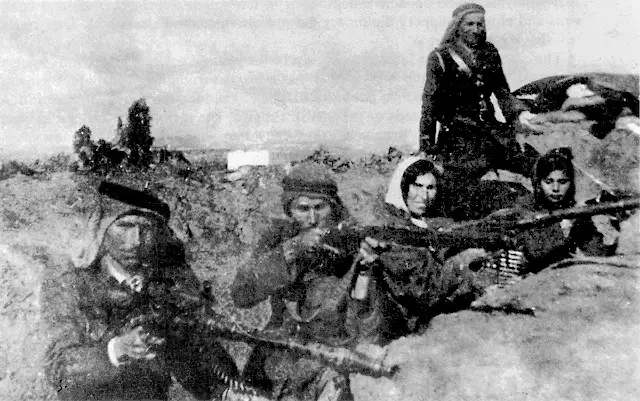
Violence erupted in Palestine in April 1936. In that month, six prominent Arab leaders overcame their rivalries and joined forces to protest Zionist advances in Palestine. The Arab High Command, as the group was known, was led by the Mufti, Haj Amin al-Husseini, and represented Arab interests in Palestine until 1948.
The Arab High Command began their protest by calling for a general strike of Arab workers and a boycott of Jewish products. These actions swiftly escalated into terrorist attacks against the Jews and the British. This first stage of the “Arab Revolt” lasted until November 1936. The second stage began in September 1937, shortly after the Peel Commission recommended the partition of Palestine. In this second phase, clashes with the British forces became much more severe, as did the attacks on Jewish settlements.
By 1936, the increase in Jewish immigration and land acquisition, the growing power of Haj Amin al-Husseini, and general Arab frustration at the continuation of European rule, radicalized increasing numbers of Palestinian Arabs. Thus, an Arab attack on a Jewish bus on on April 15, 1936, that killed three Jews led to a series of incidents that escalated into a major Palestinian rebellion. An Arab Higher Committee (AHC), a loose coalition of recently formed Arab political parties, was created. It declared a six-month national strike in support of three basic demands: cessation of Jewish immigration, an end to all further land sales to the Jews, and the establishment of an Arab national government.
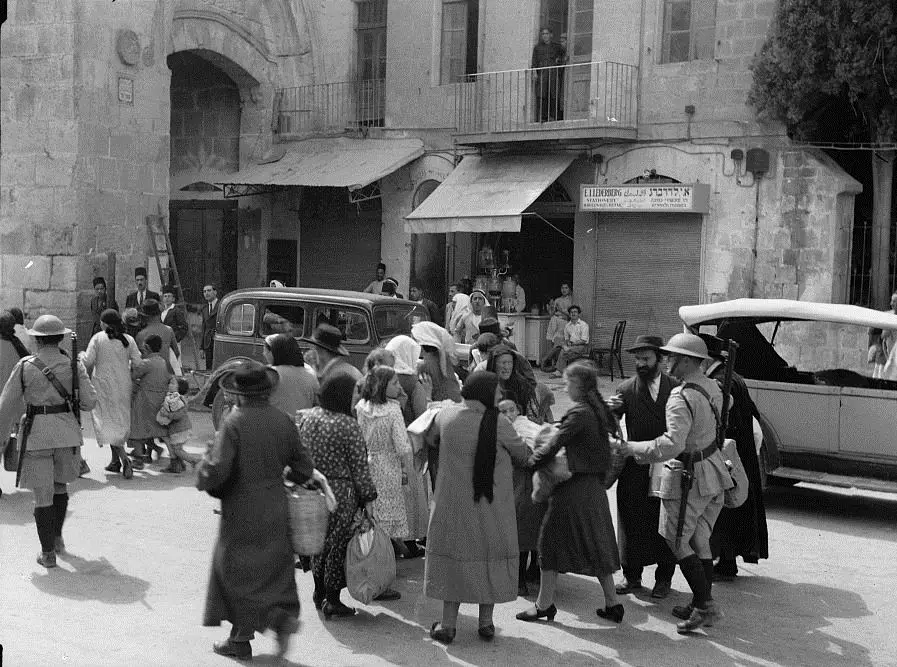
Jews evacuate the Old City of Jerusalem after Arab riots in 1936.
The intensity of the Palestinian revolt at a time when Britain was preparing for the possibility of another world war led the British to reorient their policy in Palestine. As war with Germany became imminent, Britain’s dependence on Middle Eastern oil, and therefore the need for Arab goodwill, loomed increasingly large in its strategic thinking. Jewish leverage in the Foreign Office, on the other hand, had waned; the pro-Zionists, Balfour and Samuels, had left the Foreign Office and the new administration was not inclined toward the Zionist position. Furthermore, the Jews had little choice but to support Britain against Nazi Germany. Thus, Britain’s commitment to a Jewish homeland in Palestine dissipated, and the Mandate authorities pursued a policy of appeasement with respect to the Arabs.
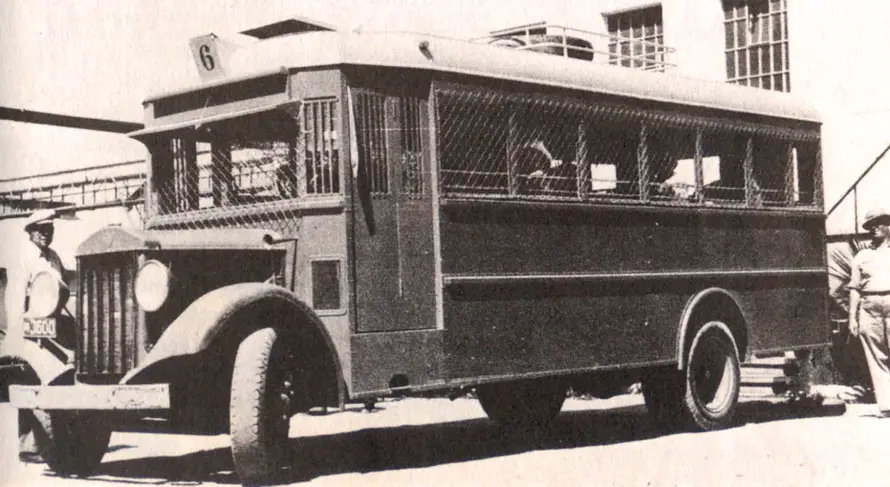
A Jewish bus equipped with wire screens to protect passengers against rocks and grenades thrown by Arabs.
Britain’s policy change in Palestine was not, however, easily implemented. Since the 1917 Balfour Declaration, successive British governments had supported (or at least not rejected) a Jewish national home in Palestine. The Mandate itself was premised on that pledge. By the mid-1930s, the Yishuv had grown to about 400,000, and the Jewish economic and political structures in Palestine were well ensconced. The extent of the Jewish presence and the rapidly deteriorating fate of European Jewry meant that the British would have an extremely difficult time extricating themselves from the Balfour Declaration. Furthermore, the existing Palestinian leadership, dominated by the Mufti, was unwilling to grant members of the Jewish community citizenship or to guarantee their safety if a new Arab entity were to emerge. Thus, for the British the real options were to impose partition, to pull out and leave the Jews and Arabs to fight it out, or to stay and improvise.
In 1937, the British, working with their regional Arab allies, Amir Abdullah of Transjordan, King Ghazi of Iraq, and King Abdul Aziz ibn Saud of Saudi Arabia, mediated an end to the revolt with the AHC. A Royal Commission on Palestine (known as the Peel Commission) was immediately dispatched to Palestine. Its report, issued in July 1937, described the Arab and Zionist positions and the British obligation to each as irreconcilable and the existing Mandate as unworkable. It recommended partition of Palestine into Jewish and Arab states, with a retained British Mandate over Nazareth, Bethlehem, and Jerusalem and a corridor from Jerusalem to the coast.
In 1937, the Twentieth Zionist Congress rejected the proposed boundaries but agreed in principle to partition. Palestinian Arab nationalists rejected any kind of partition. The British government approved the idea of partition and sent a technical team to make a detailed plan. This group, the Woodhead Commission, reversed the Peel Commission’s findings and reported in November 1937 that partition was impracticable; this view in its turn was accepted. The Palestinian revolt resumed in the autumn of 1937. The British put down the revolt using harsh measures, shutting down the AHC and deporting many Palestinian Arab leaders.
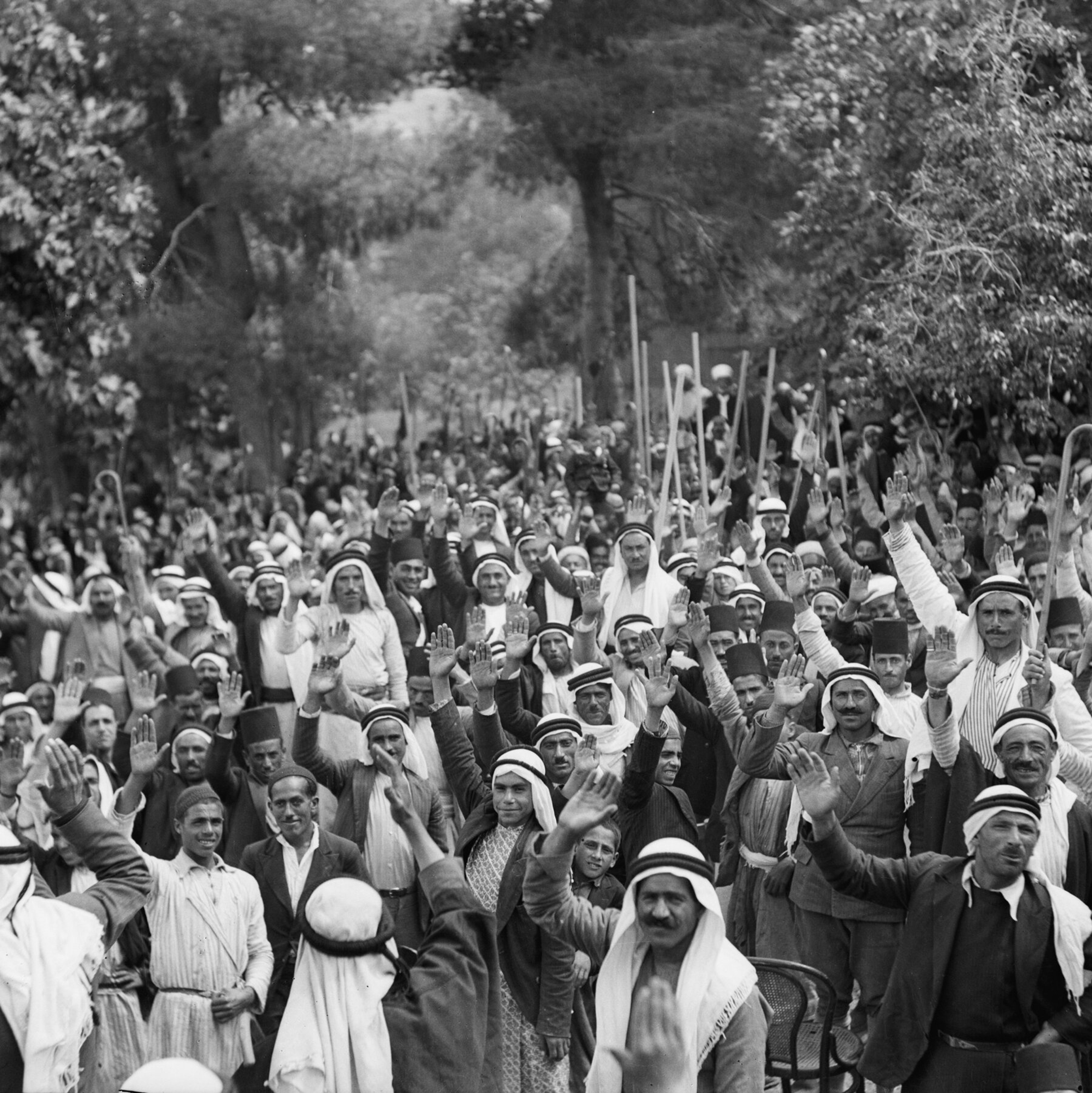
A rally of Palestinians during the Arab revolt.
With their leadership residing outside Palestine., the Arabs were unable to match the Zionists’ highly sophisticated organization. Another outcome of the Palestinian revolt was the involvement of the Arab states as advocates of the Palestinian Arabs. Whereas Britain had previously tended to deal with its commitments in Palestine as separate from its commitments elsewhere in the Middle East, by 1939 pan-Arab pressure carried increasing weight in London.
In the Yishuv, the Palestinian revolt reinforced the already firm belief in the need for a strong Jewish defense network. Finally, the Arab agricultural boycott that began in 1936 forced the Jewish economy into even greater self-sufficiency.
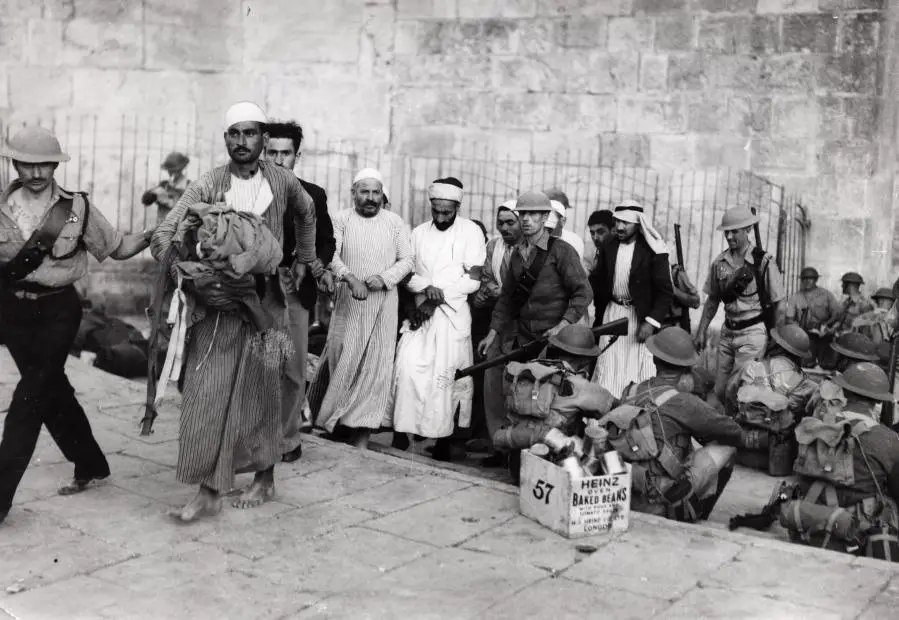
British soldiers of the Coldstream Guards cleansing
Jerusalem of Arabs participating in the revolt (1938)
To quell the revolt, the British sanctioned the arming of the Haganah. Cooperation continued until the disturbances came to an end in 1939. The ending of the disturbances was partly due to Charles Orde Wingate, an officer in the British army. Wingate, pro-Zionist and a Christian, organized Special Night Squads of Jewish volunteers to combat the attackers.
Ultimately, the British military suppressed the revolt, but the British government, in effect, rewarded the Arabs with the publication of the 1939 White Paper.
Once the rebellion was suppressed, the Yishuv entered a period of relative peace with the Arabs of Palestine. It was only the UN announcement of partition which would bring on additional hostilities and tensions.
Eighty Jews were murdered by terrorist acts during the labor strike, and a total of 415 Jewish deaths were recorded during the whole 1936-1939 Arab Revolt period. The toll on the Arabs was estimated to be roughly 5,000 dead, 15,000 wounded, and 5,600 imprisoned.
Sources: The Jewish Agency for Israel.
The World Zionist Organization.
Palestine Facts.
U.S. Library of Congress.
Arab Rebellion Breaks Out in Palestine,
Center for Israel Education.
Photos: Revolt hanini, CC BY-SA 3.0, via Wikimedia Commons.
Jewish bus - Public domain, via Wikimedia Commons.
Evacuation - Public domain, via Wikimedia Commons.
Rally - Matson Photograph Collection, Library of Congress.
British soldiers - Nationaal Archief, No restrictions, via Wikimedia Commons.
See also Photographs from 1936 Arab Riots


